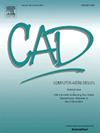利用图卷积网络自动生成 CAD 模型装配的多部分运动学约束预测
IF 3
3区 计算机科学
Q2 COMPUTER SCIENCE, SOFTWARE ENGINEERING
引用次数: 0
摘要
本文提出了一种基于机器学习的方法,用于预测可能从未组装在一起的 CAD 模型之间的运动学约束。在学习阶段,对算法进行训练,以预测装配体候选零件集之间的下一个可能约束。装配体用一种新的基于图形的形式来表示,这种形式能够捕捉与零件相关的特征、零件之间的接口以及它们之间的约束。利用这种多层次特征提取策略和逐状态图分解,该方法无需在大型数据库中进行训练。这种形式主义既可用于网络输入建模,也可用于评估后出现下一个可能约束的输出建模。该方法的核心依赖于一系列基于链接预测编码器-解码器架构的网络,整合了以端到端方式训练的多个卷积网络的功能。此外,还添加了一种决策算法,用于对输出进行后处理,并驱动预测过程,从一组下一个可能的约束条件中找到一个。这一过程不断重复,直到无法再添加更多的约束条件为止。实验结果表明,在此类装配任务中,所提出的方法优于最先进的方法。虽然逐状态装配算法是迭代式的,但它仍然考虑到了整套零件以及已预测的整套约束,这使得它可以处理约束循环,而这在不考虑多个零件作为输入时通常是不可能的。本文章由计算机程序翻译,如有差异,请以英文原文为准。
Multi-part kinematic constraint prediction for automatic generation of CAD model assemblies using graph convolutional networks
This paper presents a machine learning-based approach to predict kinematic constraints between CAD models that have potentially never been assembled together before. During the learning phase, the algorithm is trained to predict the next-possible-constraints between a set of parts candidate to the assembly. Assemblies are represented in a new graph-based formalism that is capable of capturing features associated with parts, interfaces between parts and constraints between them. Using such a multi-level feature extraction strategy coupled to a state-by-state graph decomposition, the approach does not need to be trained on a large database. This formalism is used to model both the network input and output where the next-possible-constraints appear after evaluation. The core of the approach relies on a series of networks based on a link-prediction encoder–decoder architecture, integrating the capabilities of several convolutional networks trained in an end-to-end manner. A decision-making algorithm is added to post-process the output and drive the prediction process in finding one among the set of next-possible-constraints. This process is repeated until no more constraints can be added. The experimental results show that the proposed approach outperforms state-of-the-art methods on such assembly tasks. Although the state-by-state assembly algorithm is iterative, it still takes into account the whole set of parts as well as the whole set of constraints already predicted, and this makes it possible to handle constraint cycles, which is generally not possible when not considering multiple parts as input.
求助全文
通过发布文献求助,成功后即可免费获取论文全文。
去求助
来源期刊

Computer-Aided Design
工程技术-计算机:软件工程
CiteScore
5.50
自引率
4.70%
发文量
117
审稿时长
4.2 months
期刊介绍:
Computer-Aided Design is a leading international journal that provides academia and industry with key papers on research and developments in the application of computers to design.
Computer-Aided Design invites papers reporting new research, as well as novel or particularly significant applications, within a wide range of topics, spanning all stages of design process from concept creation to manufacture and beyond.
 求助内容:
求助内容: 应助结果提醒方式:
应助结果提醒方式:


